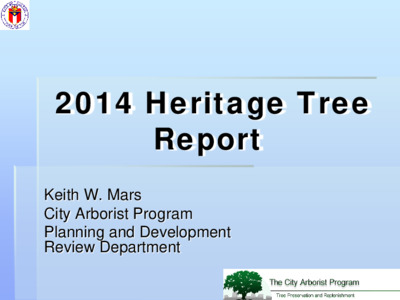H3 - City Arborist Program 2014 Annual Heritage Tree Report — original pdf
Backup

2014 Heritage Tree Report Keith W. Mars City Arborist Program Planning and Development Review Department Overview of Presentation City Arborist Workflow 2014 Heritage Tree Review - Site Plan and Subdivision Permits - Heritage Tree TORA Permits - Dead, Diseased, or Hazard Permits The Big Picture Challenges and Opportunities Predevelopment Consultation Development Review Inspection Permit Data Analysis Work Flow Overview City Arborist Development Review, Inspection, and Permit Analysis Site Plan and Subdivision Review for Heritage Trees No Land Use Commission variances Reviewed 118 site plans and subdivisions 65% and 18% increase from 2013 in # of site plans and subdivisions reviewed ~18,000 inches surveyed ~17,000 inches preserved ~1000 inches removed (95% preservation of healthy heritage trees) 2014 Heritage Tree Permits 1083 heritage trees were reviewed on tree permits in 2014 33,340 inches of trees reviewed 35 healthy heritage trees allowed to be removed American Elm 13% Bald Cypress 1% Black Walnut 0% Bur Oak 0% Cedar Elm 8% Chinquapin Oak 0% Durand Oak 0% Live Oak 41% Pecan 23% Post Oak 6% Red Oak 7% Texas Ash 1% Heritage Trees by Species Reviewed on Tree Permits in 2014 Tree Condition Permits 350 dead, diseased, or imminent hazard heritage trees were reviewed on tree permits in 2014 10842.5, inches of dead, diseased, or imminent hazard trees permitted for removal Heritage Tree Mortality on Tree Permits Species 2014 Number Reviewed 2014 Dead, Diseased, or Hazardous 2014 % Mortality 2013 % Mortality 2012 % Mortality 2011 % Mortality American Elm 143 105 73% 78% 86% 85% Cedar Elm 80 37 46% 52% 47% 50% Live Oak 445 67 15% 20% 24% 26% Pecan 249 75 30% 33% 40% 31% Post Oak 67 22 33% 39% 50% 38% Red Oak 73 37 51% 57% 71% 71% Big Picture The ordinance is working (>95% preservation rate of heritage trees) Regulatory options for means to end Programmatic reorganzation Citizens and development community engaging earlier in development process Dynamic city, dynamic forest Ensuring community values are protected Urban Forest Challenges and Opportunities 4th year as fastest growing city in country while protecting the urban forest Protection of tree species less than 19” Fulfilling vision of Imagine Austin Comprehensive Urban Forest Plan CodeNext Questions? Keith W. Mars City of Austin Arborist Program Planning and Development Review Dept. 512-974-2755 keith.mars@austintexas.gov